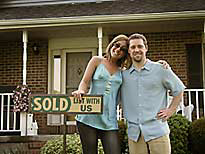

Additional Pages
The
SAN DIEGO HOME INSPECTOR .com
A Home Inspection Company


Marketing with QR codes
Are you going to be the last one to use QR codes to promote your real estate business? Hopefully not. Instead, why don’t you jump in ahead of the wave and enjoy the ride of your life. In the next few paragraphs you will learn about the vast potential QR codes have for increasing the success of your real estate business.
Perhaps you have already noticed these square barcodes are showing up on marketing materials, business cards, ads, magazines, and even on banana stickers. You may have seen these but did not known what these are or the capability they possess.
QR codes or Quick Response codes are a relatively new barcode (at least in the United States).
They have to potential to revolutionize present day marketing materials and techniques (they are already saturating marketing materials in Japan). A QR code is a barcode that can be scanned with a smartphone's camera, and once scanned, can leverage the phone’s extensive capabilities. These barcodes are amazingly flexible and are very powerful.
How can a barcode be powerful? QR codes can trigger many different cell phone functions. They can launch a website, enter a phone number for easy dialing, display text-based messages, and more. Here is a partial list of the capabilities of a QR code. Once scanned a QR code can…
Play a video file
Imagine this: a potential client drives by a home that you are selling, they scan the QR code that you put on the ‘For Sale’ sign, and they watch a video of you talking about the home that you are selling. Powerful indeed.
Launch a website
The phone’s web browser will open and take the user directly to your website. Typing in urls on a cell phone is rather laborious…scanning a barcode is fast and simple. Ideally you can have a special webpage that is designed for the cell phone’s smaller screen size.
Display your phone number & other contact info
Put a QR Code on your business card and give smartphone users the option to quickly and easily scan in your contact information. Scanning is much easier than typing it in…and once entered; your contact info has a longer lifespan than a business card.
Play an audio file
Playing an audio message is a simple way to make a more personal connection with potential clients that come upon your marketing materials.
Display your message
You can make a QR code that displays a simple paragraph of text. You can even combine text with a website URL. Thus, you can write about your real estate business and include a link to your website.
By now your mind is probably running away with creative ways to use QR codes, but you may also be wondering how to begin. To begin creating your own QR codes, simply google “QR code generator”. QRstuff.com & qrcode.kaywa.com are just a few of the many websites that will generate the QR code for you. It’s free, it’s easy, and it’s time to catch the wave. Enjoy the ride.
The San Diego Home Inspector hopes to be a useful resource for real estate professionals. Agents are extremely busy people, so we thought we would try to save them time by sharing some of the resources that we have found. Sharing is nice...don’t you think?



Download a pdf
of this article
Carbon Monoxide
Carbon monoxide is a byproduct of the combustion of natural gas, wood, or any carbon-based fuel. It is a clear, odorless, and tasteless gas, and can cause death if gone undetected. Extended exposure to low levels of carbon monoxide—sometimes not detected by inexpensive carbon monoxide alarms—can cause long-term health problems.
Because there is such a variety of carbon monoxide detectors on the market, testing, inspection, analysis, or opinion of function of carbon monoxide detectors is not within the scope of the home inspection. While I do not specifically look for carbon monoxide detectors during the course of my inspection, if I do notice them, I will note their location, and I will test them using the built-in test button. The built-in test button, however, only verifies proper battery and alarm function; it does not test carbon monoxide detecting capabilities. There are many different types of carbon monoxide detectors available, some that can simply be plugged into an electric outlet. Some outlet plug-in units might have been present but might not have been visible due to furnishings and storage, and they might have been taken by the sellers when they moved out.
While most legal statutes in most states require that working smoke alarms be present at the close of escrow, the same, sadly, is not required of carbon monoxide detectors. I recommend adding carbon monoxide detectors to bedrooms and any other areas where people are likely to fall asleep, such as a near a cozy fireplace, in the family room with a comfortable couch and an entertainment system. I also recommend installing at least two carbon monoxide detectors in all residences to provide backup protection if a dead battery is present in one or if a detector is defective or fails.
I also recommend testing carbon monoxide detectors at move-in, installing fresh batteries, and testing them monthly. If the present detectors are old, or you do not know their age, I recommend simply replacing them. Carbon monoxide is a deadly killer, and the cost of carbon monoxide detectors is worth every penny if they can save a life. It is better to be safe than sorry.